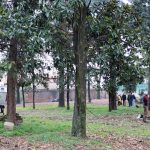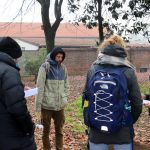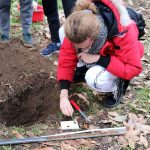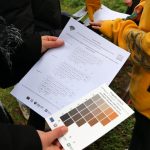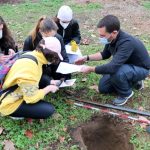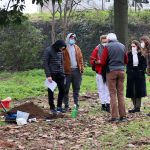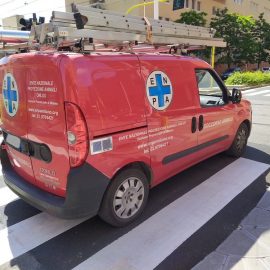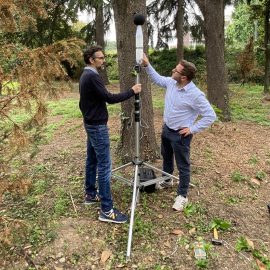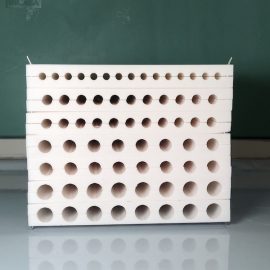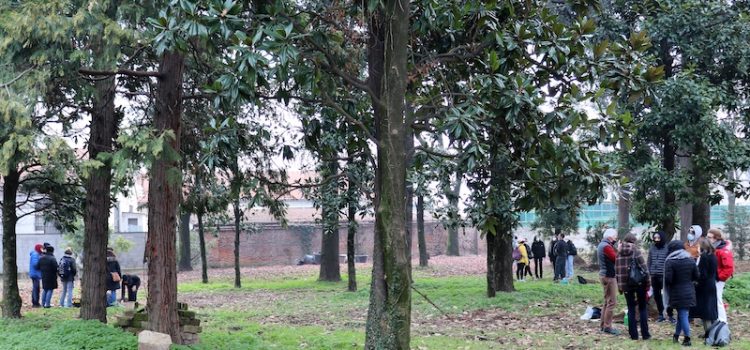
Open-air laboratory: students from the Geopedology course at the Vivaio Bicocca
Over the past few days, the Vivaio Bicocca site has become an area of study for students on the Geopedology course (three-year degree in Environmental Science and Technology). With the assistance of the teachers (Roberto Comolli and Chiara Ferré), around 70 students, divided into three field days, braved the rigours of winter to study the soils of the nursery.
In order to gain a better understanding of the soils, it is absolutely essential to be able to go on educational trips, because this is the only way to get the participants to "touch with their hands" the object of study, i.e., the soil itself. The first outing of the course took place on the morainic hills to the north of Milan, to learn about natural and agricultural soils. The second outing took place in the Bicocca Nursery, where the soils are very different from the natural ones: they are anthropogenic, urban soils with very interesting and even unsuspected characteristics.
Urban soils, which are present in all cities, are almost always heavily disturbed and reworked, with the addition of foreign materials or the removal of the most fertile part of the surface, or sealed by impermeable covers: in short, the natural characteristics are heavily modified. The soils of the Vivaio are no exception to the rule: originally, they were agricultural land (meadows or arable land), but over time they have undergone many processes of modification, which have affected even considerable thicknesses (in some places more than a metre deep): they are therefore typical anthropic soils. From this point of view, the Nursery is an optimal site for studying these soils, which are normally considered to be of poor quality, but which on the other hand may have properties of great environmental value.
Over the course of the days, various techniques for studying soils were demonstrated and put into practice: use of the soil probe, identification of profile horizons, estimation of organic matter content from colour, pH measurement, carbonate assessment, sampling for bulk density, measurement of water infiltration rate, measurement of CO2 emission from the surface (i.e., soil respiration), use of a technique for visual assessment of soil quality.
These initial investigations have shown that the soils in the Vivaio Bicocca, as is often the case with urban soils, have very interesting characteristics and properties:
- First, they contain organic matter in considerable quantities, not only on the surface but also at depth. Soil organic matter derives from plant residues (roots, aerial part of vegetation) and contains high amounts of carbon, coming from atmospheric CO2 and organicised by plants through photosynthesis. In this sense, soil can be said to store large quantities of CO2 and thus limit the greenhouse effect. From this point of view, nursery soils play a very important role, even more so than cultivated soils (the latter are often lacking in organic matter due to unbalanced management methods);
- the soils studied have pH values that are sub-acidic or close to neutral. If we add that the soil texture is average (i.e., there is no excess sand or clay) and that, as mentioned above, it is rich in organic matter, it can be said that it has a good level of fertility and is therefore capable of hosting a rich vegetation (as demonstrated by the development of the trees present);
- the pedological characteristics mentioned above (medium texture and high presence of organic matter) give these soils a good infiltration rate: they are therefore able to allow rainwater to infiltrate effectively, preventing it from flowing to the surface and causing erosion and hydraulic problems for the city.
All in all, these study days have made it possible to get to know the characteristics of the nursery soils and to appreciate their qualities, demonstrating that urban soils sometimes possess environmental qualities superior to those of cultivated soils.

